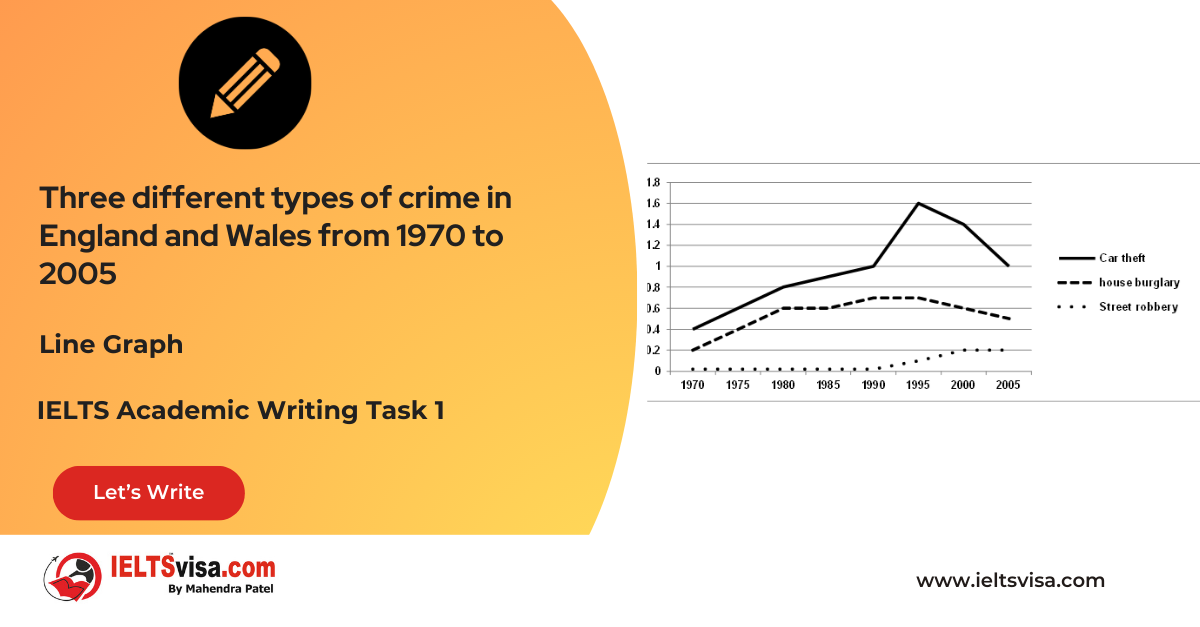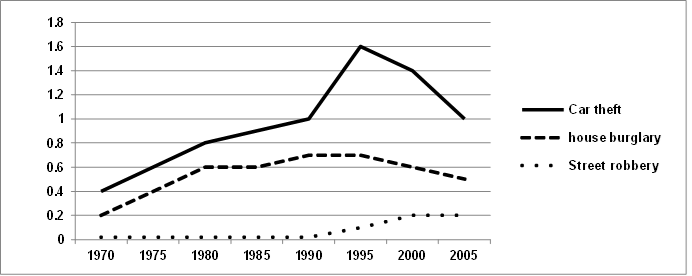Three different types of crime in England and Wales from 1970 to 2005
IELTS Academic Writing Task 1 - Line Graph

IELTS Writing Task 1 Question
The chart below shows three different types of crime in England and Wales from 1970 to 2005. Summarize the information by selecting and reporting the main features, and make comparisons where relevant.

Common Questions for the Line Graph
1. Graph Type: Line Graph
2. Title: Types of Crime in England and Wales (1970–2005)
3. What are the units of measurement?: Number of crimes (in millions)
4. Who: Crimes in England and Wales
5. When: 1970 to 2005
6. Where: England and Wales
7. Topic: Trends in car thefts, house burglaries, and street robberies
Comparison Showing and Trends Any change over time (such as an increase or a decrease) is a trend.
Comparison 1 : Car Thefts (Highest)
- Details:
-
- Dominated throughout the period, starting at 0.4 million in 1970.
2. Peaked at 1.6 million in 1995 before declining to 1 million by 2005.
Comparison 2: : House Burglaries
-
Details:
- Started at 0.2 million in 1970, increasing moderately for the first decade.
2. Fluctuated after 1980, ending at 0.5 million by 2005.
Comparison 3 : Street Robberies (Lowest)
Details:
-
- Remained minimal at 0.01 million until 1990.
2. Grew to 0.2 million by 2000, with stability thereafter.
Sample Answer
The line graph compares the trends in car thefts, house burglaries, and street robberies in England and Wales between 1970 and 2005.
Overall, car thefts were the most common type of crime, while street robberies were the least reported throughout the period.
Car thefts began at 0.4 million in 1970, twice the number of house burglaries. From 1970 to 1990, car thefts rose steadily to 1 million. Between 1990 and 1995, the figure increased sharply, peaking at 1.6 million. However, a significant decline followed, and by 2005, car thefts dropped to 1 million.
House burglaries showed a similar initial trend, increasing steadily for the first decade. However, after 1980, the numbers fluctuated, ultimately reaching 0.5 million in 2005.
Street robberies were negligible from 1970 to 1990, with only 0.01 million cases reported. This number increased moderately to 0.2 million by 2000, remaining stable thereafter.
Top 27 Vocabularies
| Vocabulary | Type | Meaning | Synonyms | Examples |
| Fluctuate | Verb | To rise and fall irregularly | Vary, Oscillate | House burglaries fluctuated after 1980. |
| Stability | Noun | A state of consistency or lack of change | Steadiness, Consistency | Street robberies showed stability after 2000. |
| Escalation | Noun | A sharp increase | Surge, Rise | There was a dramatic escalation in car thefts by 1995. |
| Minimal | Adjective | Very small in amount or degree | Negligible, Few | Street robberies were minimal until 1990. |
| Trend | Noun | A general direction in which something is developing | Pattern, Tendency | “The trend in car thefts increased sharply from 1990 to 1995.” |
| Significant | Adjective | Having considerable importance or effect | Notable, Remarkable | “There was a significant decline in car thefts after 1995.” |
| Reported | Verb | To give an account of something | Documented, Recorded | “Street robberies were least reported between 1970 and 1990.” |
| Rise | Verb | To increase in amount, number, or importance | Grow, Ascend | “House burglaries rose steadily until 1980.” |
| Steady | Adjective | Maintaining a constant or uniform rate | Constant, Unchanging | “Car thefts rose steadily from 1970 to 1990.” |
| Negligible | Adjective | So small or unimportant as to be not worth considering | Insignificant, Minor | “Street robberies were negligible in the early years.” |
| Moderate | Adjective | Occurring within reasonable limits; not extreme | Reasonable, Average | “Street robberies increased moderately by 2000.” |
| Sharp | Adjective | Marked by a sudden and noticeable change or increase | Sudden, Abrupt | “There was a sharp rise in car thefts between 1990 and 1995.” |
| Decline | Verb/Noun | A decrease in number or quality | Drop, Fall | “There was a decline in car thefts by 2005.” |
| Report | Verb | To give an account of something | Inform, Describe | “The data reported an increase in house burglaries.” |
| Similar | Adjective | Having characteristics in common | Comparable, Alike | “House burglaries followed a similar trend to car thefts.” |
| Remain | Verb | To continue to be something or stay in a particular state | Stay, Persist | “Street robberies remained stable after 2000.” |
| Escalate | Verb | To increase or become more intense | Intensify, Amplify | “Car thefts escalated rapidly between 1990 and 1995.” |
| Negligibly | Adverb | In such a small amount that it has no effect | Inconsequentially, Minimally | “Street robberies increased negligibly before 1990.” |
| Fluctuating | Adjective | Changing frequently or irregularly | Varying, Oscillating | “House burglaries showed fluctuating patterns after 1980.” |
| Peak | Noun | The highest point reached in a given period | High, Zenith | “Car thefts peaked at 1.6 million in 1995.” |
| Increase | Verb | To become larger or greater in size or amount | Grow, Expand | “The number of street robberies increased after 1990.” |
| Stable | Adjective | Not likely to change or fluctuate significantly | Steady, Constant | “The street robbery rate remained stable after 2000.” |
| Substantial | Adjective | Of considerable importance, size, or worth | Significant, Considerable | “The decline in car thefts was substantial by 2005.” |
| Rise sharply | Verb Phrase | To increase suddenly and significantly | Surge, Soar | “Car thefts rose sharply after 1990.” |
| Trendline | Noun | A line on a graph that shows the general direction of change | Path, Trajectory | “The trendline for house burglaries increased in the 1970s.” |
| Overtake | Verb | To surpass or exceed in amount or progress | Surpass, Outstrip | “Car thefts overtook house burglaries in 1995.” |
| Stabilized | Verb | To become steady and unchanging | Balanced, Secured | “Street robberies stabilized by 2000.” |

Our Books
Master IELTS Speaking Part 1
IELTS Writing Task 1 Book
IELTS Writing Task 2 Book
Writing Task 1 Question Types
Practice IELTS Other Modules
IELTS Listening
The IELTS Listening test assesses how well you can understand spoken English in various contexts. It lasts about 30 minutes and is divided into four sections with a total of 40 questions. The listening tasks become increasingly difficult as the test progresses.
IELTS Academic Reading
The IELTS Academic Reading section assesses your ability to understand and interpret a variety of texts in academic settings. It is designed to evaluate a range of reading skills, including skimming for gist, reading for main ideas, reading for detail, understanding inferences, and recognizing a writer's opinions and arguments.
IELTS Speaking
The IELTS Speaking test assesses your ability to communicate in English on everyday topics. It lasts 11-14 minutes and consists of three parts: introduction, cue card, and a discussion based on the cue card topic.
IELTS General Reading
IELTS General Reading tests your ability to understand and interpret various types of texts. Here are some key areas and types of content you can expect to encounter in the reading section, along with tips for effective preparation.
IELTS Academic Writing Task 1
In IELTS Academic Writing Task 1, you are presented with a visual representation of information, such as graphs, charts, tables, or diagrams, and you are required to summarize, compare, or explain the data in your own words.
IELTS General Writing Task 1
In IELTS General Writing Task 1, you are required to write a letter based on a given situation. The letter can be formal, semi-formal, or informal, depending on the prompt. Here’s a breakdown of the key components to include in your letter
IELTS Academic Writing Task 2
In IELTS Academic Writing Task 2, you are required to write an essay in response to a question or topic. Here’s a guide to help you understand the essential elements of this task
IELTS Exam Tips
To succeed in the IELTS exam, practice regularly, familiarize yourself with the test format, improve your vocabulary, develop time management skills, and take mock tests to build confidence.
Grammer for IELTS
Grammar is the foundation of effective communication in English. Understanding tense usage, subject-verb agreement, and sentence structure enhances clarity and coherence in writing and speaking.
Vocabulary for IELTS
Vocabulary plays a crucial role in the IELTS (International English Language Testing System) exam, especially in the Speaking and Writing sections. Here’s an overview of why vocabulary is important and how it impacts your performance
RECENT IELTS SAMPLES QUESTIONS AND ANSWERS
Task 1 – Column graph – Percentage of Young People Enrolled in Universities in 2000 and 2007.
20:00 Start Pause Stop [df_adh_heading title_infix="IELTS Writing Task 1 Question" use_divider="on"...
Task 1 – Bar Graph – Annual Teaching Hours by Teachers in Different Countries (2001)
20:00 Start Pause Stop [df_adh_heading title_infix="IELTS Writing Task 1 Question" use_divider="on"...
Task 1 – Pie Charts – Coffee Production, Consumption, and Profit Distribution Worldwide
20:00 Start Pause Stop [df_adh_heading title_infix="IELTS Writing Task 1 Question" use_divider="on"...
Task 1 – Column graph – Types of Transport Used by Tourists Visiting New Zealand from Five Countries in 2004.
20:00 Start Pause Stop [df_adh_heading title_infix="IELTS Writing Task 1 Question" use_divider="on"...
Task 1 – Bar and Pie Chart Combination – Employment Types in 1998 and 2001
20:00 Start Pause Stop [df_adh_heading title_infix="IELTS Writing Task 1 Question" use_divider="on"...
Task 1 – Diagram – Comparison of Stone Tool Development Over Time
20:00 Start Pause Stop [df_adh_heading title_infix="IELTS Writing Task 1 Question" use_divider="on"...













